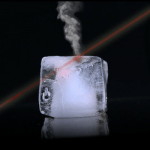A laser power sensor absorbs laser power while measuring it; if that power is not removed at least as fast as it comes in, the sensor could overheat and fail.
Many of Ophir’s OEM power sensors have a maximum average power specification of “XX watts free standing, YY watts heat sinked”. How does one make sure that a sensor has been provided with proper heat sinking? While we do not provide heat sinks, we do offer some guidelines.
We need to consider 2 separate issues:
- Conduction of heat out of the sensor into the heat sink
- Dissipation of the heat from the heat sink to the air
Conduction of heat out of the sensor into a heat sink
A heat sink will normally be attached to a specific side of the sensor body (generally both sides of the OEM sensor are provided with screw holes so either side can be used for this purpose). A useful rule of thumb is that when heat sinked with thermal heat sink compound, 4W of power can be removed by conduction for each cm2 of conduction surface area. For example, if we consider our 20C-A family of thermal OEM sensors, we note that the maximum average power is specified as 4W free standing, 20W heat sinked. The heat sink is normally attached to one of the sides having surface of area 38mm x 34mm, or about 13 cm2. Using our rule of thumb of 4W/cm2 of conduction surface area in contact with a heat sink, we could in principle remove up to 50W from the 20C-A – certainly more than the sensor’s rated maximum of 20W – if a suitable heat sink is used and is in good thermal contact with the sensor body.
Dissipation of the heat from the heat sink to the air
Regarding the surface area that dissipates the heat to the air, we can apply another rule of thumb that says approximately 6cm2 of surface area can dissipate about 1W into the air. Based on this, we can estimate that the surface area of a heat sink for enabling the 20C-A to handle 20W should be roughly 120cm2 or so at least. It is important to note that usually the sensor is mounted to some sort of metal plate inside the host system and this metal plate is often attached to the chassis of the host system. If there is good thermal contact between the sensor and the metal plate (using thermal grease for example) and between the metal plate and the chassis, then this is usually enough for proper heat dissipation.
Of course, if the ambient temperature in the environment of the sensor is higher than room temperature, that will make heat dissipation more difficult and will have to be taken into account.
You might also like to read: Ophir OEM Options












Leave a Reply
Your email address will not be published. Required fields are marked *